Complete Solutions to Illustration of chapter CHEMICAL KINETICS of Class 12 book with complete answers and questions
| Class 12 | CHEMISTRY |
| Chapter | CHEMICAL KINETICS |
| CENGAGE CHEMISTRY | Illustration |
| Number Of Questions | 100 |
| Academic Year | 2023-24 |
The decompoistion of `N_(2)O_(5)` in `C CI_(4)` solution at `318 K` has been studied by monitoring the concentration of `N_(2)O_(5)` in the solution. Initially, the concentration of `N_(2)O_(5)` is `2.33 M` and after `184 min`, it is reduced to `2.08 M`. The reaction takes place according to the equation:
`2N_(2)O_(5) rarr 4NO_(2) + O_(2)`
Calculate the average rate of this reaction in terms of hours, minutes, and seconds. What is the rate of Production of `NO_(2)` during this periof?05:19View SolutionExpress the rate of the following reactions:
(a) `PCl_(5) rarr PCl_(3) + Cl_(2)`
(b) `2NO_(2) rarr 2NO + O_(2)`
in terms of the concentrations of reactants and Products.04:01View SolutionFor each of the following reactions, express the given rate of change of concentration of the reactants or Products in that reaction:
a.`H_(2)O_(2) + 2H^(o+) + 3l^(ɵ) rarr I_(3)^(ɵ) + 2H_(2)O`, `(-d[I^(ɵ)])/(d t) = ?`, `(-d[H^(o+)])/(d t) ? `
(b) `16H^(o+) + 2Mn_(4)^(ɵ) + 101^(ɵ) rarr 2Mn^(2+) + 8H_(2)O + 5I_(2)`, `(-d[MNO_(4)^(ɵ)])/(d t) = ?`
( c) `4NH_(3) + 5O_(2) rarr 4NO_(2) + 6H_(2)O` , `(-d[NH_(3)])/(d t) = ?`07:18View SolutionAmmonia and oxygen react at high temperature as:
`4NH_(3) (g) + 5O_(2)(g) rarr 4NO(g) + 6H_(2)O (g)`
In an experiment, the rate of formation of `NO` is `3.6 xx 10^(-3) Ms^(-1)`. Calculate (a) the rate of disappearance of ammonia and (b) the rate of formation of water.04:20View SolutionThe following reaction was carried out in water :
`Cl_(2) + 2I^(ɵ) rarr I_(2) + 2Cl^(ɵ)`
The initial concentration of `I^(ɵ)` was `0.25 mol L^(-1)` and the concentration after `10 min` was `0.23 mol L^(-1)`. Calculate the rate of disappearance of `I^(ɵ)` and rate of appearance of `I_(2)`.03:31View SolutionFor a reaction `Rto P`, the concentration of a reactant changes from 0.03 M to 0.02M in 25 minutes. Calculate the average rate of the reaction using the units of seconds.
03:04View SolutionIn the following reaction, how is the rate of appearance of the underlined Product related to the rate of disappearance of the underlined reactant ?
`BrO_(3)^(ɵ)(aq) + 5underline(Br)^(ɵ)(aq) + 6H^(o+) (aq) rarr 3underline(Br_(2))(l) + 3H_(2)O(l)`02:32View SolutionFor the reaction
`H_(2) (g)+I_(2)(g) rarr 2HI(g)`, the rate of disappearance of `HI` will be `1.0 xx 10^(-4) mol L^(-1) s^(-1)`. The rate of appearance of `HI` will be02:20View SolutionThe rate of reaction is expressed as :
`(1)/(2)(+d)/(d t)[C] = (1)/(3)(-d)/(d t)[D] = (1)/(4)(+d)/(d t)[A] = -(d)/(d t)[B]`
The reaction is:02:52View SolutionThe term `-dx//dt` in the rate expresison refers to the
02:57View SolutionIn a catalyst experiment involving the Haber process `N_(2) + 3H_(2) rarr 2NH_(3)`, the rate of reaction was measured as
Rate `= (Delta[NH_(3)])/(Delta t) = 2.0 xx 10^(-4) mol L^(-1) s^(-1)`
What is the rate of reaction expressed in terms of (a) `N_(2)` (b) `H_(2)` ?03:02View SolutionThe approach to the following equilibrium was observed kinetically form both directions:
`[PtCl_(4)]^(2-) +H_(2)O hArr [Pt(H_(2)O)Cl_(3)]^(ɵ)+Cl^(ɵ)`
At `25^(@)C` it was found that at `0.3` inoic strength `- (Delta [PtCl_(4)]^(2-))/(Delta t) = (3.9 xx 10^(-5)s^(-1))[PtCl_(4)]^(2-)`
`- (2.1 xx 10^(-3) L mol^(-1) s^(-1))[Pt(H_(2)O)Cl_(3)]^(ɵ)[Cl_(3)^(ɵ)]`
What is the value of `k` for the complexation of the fourth `Cl^(ɵ)` by `Pt(II)` at `0.3` ionic strenght.03:01View SolutionWhich of the following expression can be used to describe the instantaneous rate of the reaction ?
`2A+B rarr A_(2)B`01:24View SolutionWhich of the following will react at the highest rate ?
02:44View SolutionThe reaction between `Cr_(2)O_(7)^(2-)` and `HNO_(2)` in an acidic medium is
`Cr_(2)O_(7)^(2-) + 5H^(o+) + 3HNO_(2) rarr 2Cr^(3+) + 3NO_(3)^(ɵ) + 4H_(2)O`.
The rate of disappearance of `Cr_(2)O_(7)^(2-)` is found to be `2.4 xx 10^(-4) mol L^(-1) s^(-1)` during measured time interval. What will be the rate of disappearance of `HNO_(2)` during the same time interval?03:35View SolutionThe complexation of `Fe^(2+)` with the chelating agent dipyridyl has been studied Kinetically in both the forward and reverse direction, For the complexation reaction `Fe^(2+)+3` dipy `rarr [Fe(dipy)_(3)]^(2+)`, the rate of formation of the complex at `25^(@)C` is given by
Rate `= (1.45 xx 10^(13) L^(3) mol^(-3) s^(-1)) [Fe^(2+)][dipy]^(3)` and for the reverse of the above eqaution, the rate of disappearance of the complex is
`(1.22 xx 10^(-4) s^(-1)) [Fe(dipy)_(3)]^(2+]`
What is `K_(s)`, the stability constant for the complex ?02:58View SolutionFor the reaction at `273 K`
`NO(g) + O_(3)(g) rarr NO_(2)(g) + O_(2)(g)`
It is observed that the pressure of `NO(g)` falls form `700 mm Hg` to `500 mm Hg` in `250 s`. Calculate the average rate of reaction in (a) `atm s^(-1)` , (b) `mol L^(-1) s^(-1)`.04:27View SolutionThe hydrogenation of vegetable ghee at `25^(@)C` reduces the pressure of `H_(2)` form `2 atm` to `1.2 atm` in `50min`. Calculate the rate of reaction in terms of change of
(a) Pressure per minute
(b) Molarity per second02:42View SolutionFor gaseous reactions, the rate is expressed in terms of `dP//dt` instead of `dc//dt` or `dn//dt` (where `c` is the concentration and `n` the number of `mol`). What is the relation among these expresisons ?
01:34View SolutionIn the reaction, `2H_(2)O_(2) rarr 2H_(2)O + O_(2)` The rate of decompoistion of `H_(2)O_(2)` is `0.68 kg hr^(-1)`. What is the rate of formation of `O_(2)` and `H_(2)O` in `kg hr^(-1)` ?
05:17View SolutionCalculate the overall order of a reaction which has the rate expresison.
(a) Rate`= k[A]^((1)/(2))[B]^((3)/(2))` , (b) Rate `= k[A]^((3)/(2))[B]^(-1)`01:41View SolutionFrom the rate laws for the reactions given below, determine order with order to each species and the overall order:
(a) `2HCrO_(4)^(ɵ) + 6l^(ɵ) + 14H^(o+) rarr 2Cr^(3+) + 3I_(2) + 8H_(2)O`
Rate `= k[HCrO_(4)^(ɵ) ][I^(ɵ) ]^(2) [H^(o+)]^(2)`
(b) `H_(2)O_(2) + 2I^(ɵ) +2H^(o+) rarr I_(2)+2H_(2)O`
Rate `= k[H_(2)O_(2)] [I^(ɵ) ]`02:33View SolutionThe rate constant for the reaction, `2N_(2)O_(5) rarr 4NO_(2) + O_(2)` is `3.0 xx 10^(-5) s^(-1)`. If the rate is `2.40 xx 10^(-5) mol L^(-1) s^(-1)`, then the initial concentration of `N_(2)O_(5)` (in `mol L^(-1)`) is
01:44View SolutionThe decompoistion of ammonia on platinum surface follows the change
`2NH_(3) rarr N_(2) + 3H_(2)`
(a) What does `(-d[NH_(3)])/(dt)` denote?
(b) What does `(d[N_(2)])/(dt)` and `(d[H_(2)])/(dt)` denote?
( c) If the decompoistion is zero order then what are the rates of Production of `N_(2)` and `H_(2)` if `k = 2.5 xx 10^(-4) M s^(-1)` ?
If the rates obeys `- (d[NH_(3)])/(d t) = (k_(1)[NH_(3)])/(1+k_(2)[NH_(3)])`, what will be the order for decompoistion of `NH_(3)`, if (i) `[NH_(3)]` is every less and (ii) `[NH_(3)]` is very high? (`k_(1)` and `k_(2)` are constants)07:18View SolutionThe rate constant for the reaction:
`CO_(2) + overset(ɵ)(OH) rarr HCO_(3)^(ɵ)`
in the aqueous solution is `4 xx 10^(-3) L mol^(-1) s^(-1)`. Calculate the number of mole of `CO_(2)` and `overset(ɵ)(OH)` are `10^(-6)` and `10^(-1) mol L^(-1)`. Also predict the mole of `HCO_(3)^(ɵ)` formed per second.02:07View SolutionFor a reaction `3A rarr` Products, it is found that the rate of reaction doubles. If the concentration of `A` is increased four times, calculated the order of reaction.
02:17View SolutionThe rate of a reaction starting with initial concentration of `2 xx 10^(-3)` and `1 xx 10^(-3) M` are equal to `2.40 xx 10^(-40)` and `0.60 xx 10^(-4) M s^(-1)`, respectively. Calculate the order or reaction w.r.t. reactant and also the rate constant.
04:10View SolutionThe reaction `2A + B + C rarr D + 2E` is found to be first order in `A`, second order in `B` and zero order in `C`.
(a) Write the rate expresison.
(b) What is the effect on rate on increaisng the concentration of `A, B`, and `C` two times ?03:21View SolutionFor `2A + B + underset((excess))(C ) rarr` Products, calculate:
(a) Rate expresison, uisng rate law.
(b) Units of rate and rate constant.
(c ) Effect on rate, if the concentration of `A` is doubled and that of `B` is tripled.04:35View SolutionThe rate of reaction: `2NO(g) + Cl_(2) (g) rarr 2NOCl (g)`, becomes doubled when the concentration of `Cl_(2)` is doubled. However, when the concentration of both the reactants are doubled, the rate becomes eight times. What is the order w.r.t. `NO` and w.r.t. chlorine ? What is the total order?
03:57View SolutionShow by uisng rate laws how much the rate of reaction `2NO(g) + O_(2)(g) rarr 2NO(g)` will change if the volume of the reaction vessel is diminished to `1//3` of its initial volume.
02:24View SolutionWhat would be the effect on the rate of reaction due to the four-fold increase in a reactant concentration, if the order of reaction were the following:
(a) Zero order , (b) First order
( c) `1//2` order , (d) Fourth order04:10View SolutionThe experiment rate law for the reaction `S_(2)O_(8)^(2-)(aq) + 2I^(ɵ)(aq) rarr 2SO_(4)^(2-) (aq) + I_(2)(aq)` is `k[S_(2)O_(8)^(2-)] [I^(ɵ)]`. How would the rate change if
(a) Concentration of `S_(2)O_(8)^(2-)` is halved.
(b) Concentration of `S_(2)O_(8)^(2-)` and `I^(ɵ)` are halved.02:31View SolutionFor the reaction `A + B rarr C + D`, doubling the concentration of both the reactants increases the reaction rate by `8` times and doubling the initial concentration of only `B` ismply doubles the reaction rate. What is the rate law for the reaction ?
04:20View SolutionFor the non-equilibrium process, `A + B rarr` Product, the rate is first-order w.r.t. `A` and second order w.r.t. `B`. If `1.0 mol` each of `A` and `B` were inrofuced into `1.0 L` vessel and the initial rate was `1.0 xx 10^(-2) mol L^(-1) s^(-1)`, calculate the rate when half the reactants have been turned into Products.
03:29View SolutionThe rate constant in numerically the same for the theee reaction of first, second, and third order. Which reaction should be the fastest and it this true for all ranges of concentrations?
03:32View SolutionThe rate law for the following reactions:
`Ester + H^(o+) rarr "Acid" + "Alcohol"`, is
`dx//dt = k(ester)[H_(3)O^(o+)]^(0)`
What would be the effect on the rate if
(a) concentration of ester is doubled.
(b) concentration of `H^(o+)` ion is doubled.02:41View SolutionMechanism of the reaction is:
`A_(2) overset(k_(1))hArr 2A`
`A + B overset(k_(2))rarr C`
`A_(2) + C overset(k)rarr D + A`
What is (a) `(-d[A_(2)])/(dt)`, (b) `(-d[A])/(dt)`, (c ) `(d[C])/(d t)`, (d) `(d[D])/(dt)` ?06:11View SolutionMechanism of the reaction is:
`A overset(k_(1))rarrB, 2Aoverset(k_(2))rarr C + D`
What is `(-d[A])/(dt)` ?01:13View SolutionMechanism of the reaction is:
What is `(-d[A])/(dt)` ?01:55View SolutionMechanism of the reaction is:
`A underset(k_(1))overset(k_(2))hArr B` ...(i)
`B+A overset(k_(3))hArr C` ...(ii)
`ul(bar(2A rarr C))` ...(iii)
What is (a) `(-d[A])/(dt)`, (b) `(d[B])/(dt)` , (c ) `(d[C])/(dt)`03:50View SolutionMechanism of the reaction is:
`A_(2) overset(k_(2))hArr 2A`
`A + B overset(k_(2))rarr C`
`A_(2) + C overset(k)rarr D + A`
What is (a) `(-d[A_(2)])/(dt)`, (b) `(-d[A])/(dt)`, (c ) `(d[C])/(d t)`, (d) `(d[D])/(dt)` ?06:11View Solution`2N_(2)O_(5) rarr 4NO_(2) + O_(2)`
If `(-d[N_(2)O_(5)])/(dt) = k_(1)[N_(2)O_(5)]`
`(d[NO_(2)])/(dt) = k_(2)[N_(2)O_(5)]`
`(d[O_(2)])/(dt) = k_(3)[N_(2)O_(5)]`
What is the relation between `k_(1), k_(2)`, and `k_(3)`?02:14View Solution`2SO_(2) + O_(2) underset(k_(2))overset(k_(1))hArr 2SO_(3)`
What are the expresison for the rate law of the forward and backward reactions?01:51View SolutionMechanism of the reaction is:
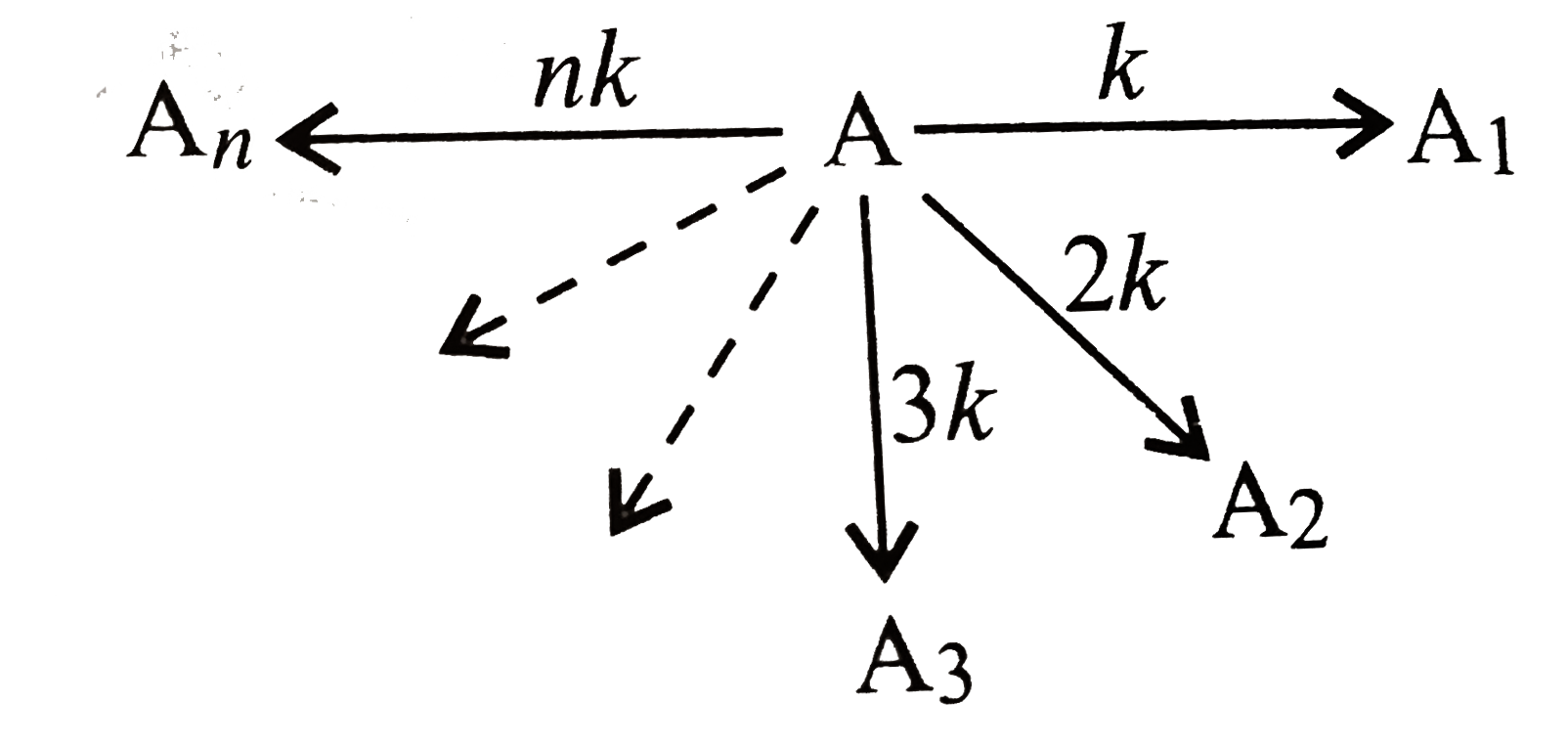
What is (a) `(-d[A])/(dt)`, (b) `(d[A_(1)])/(dt)` , (c ) `(d[A_(n)])/(dt)`, (d) `(d[A_(1)])/(-d[A])` for same time?04:05View SolutionThe rate law for the decompoistion of gaseous `N_(2)O_(5)`,
`N_(2)O_(5)(g) rarr 2NO_(2)(g) + (1)/(2)O_(2)(g)` is observed to be:
`r = (-d[N_(2)O_(5)])/(dt) = k[N_(2)O_(5)]`
A reaction machanism which has been suggested to be conisstent with this rate law is
`N_(2)O_(5)(g) overset(k_(eq))hArr NO_(2)(g)+NO_(3)(g) ("fast equilibrium")`
`NO_(2) (g) + NO_(3)(g) overset(k_(1))rarr NO_(2)(g) + NO(g) + O_(2)(g)` (slow)
`NO(g) + NO_(3)(g) overset(k_(2))rarr 2NO_(2)(g)` (fast)02:46View SolutionThe termolecular reaction
`2NO(g) + H_(2)(g) rarr 2NOH(g)` is found to be third order obeying the rate law `r = k[NO]^(2)[H_(2)]`. Show that it is conisstent with either of the following mechanisms:
(a) `2NO(g) overset(k_(eq))hArr N_(2)O_(2)(g) ("fast equilibrium")`
`N_(2)O_(2)(g) + H_(2)(g) overset(k')rarr 2NOH(g)` (slow)
(b) `2NO(g) +H_(2)(g) overset(k'_(eq))hArr NOH_(2)(g) ("fast equilibrium")`
`NOH_(2)(g) + NO(g) overset(k'')rarr 2NOH(g)` (slow)05:35View SolutionFor and elementary reaction
`2A underset(k_(2))overset(k_(1))hArr B`, the rate of disappearance of `A` iss equal to
(a) `(2k_(1))/(k_(2))[A]^(2)`
(b) `-2k_(1)[A]^(2) + 2k_(2)[B]`
( c) `2k_(1)[A]^(2) - 2k_(2)[B]`
(d) `(2k_(1) - k_(2))[A]`01:37View SolutionConisder the following reactions:
I. `A+B underset(k_(-1))overset(k_(1))hArr C`
II. `C + B overset(k_(2))rarr D`
Then `k_(1)[A][B]-k_(-1)[C]-k_(2)[C][B]` is equal to02:59View SolutionThe rate expresison of some reactions are given below. Propose a probable mechanism of each of the following reactions:
(a) `2N_(2)O_(5) rarr 4NO_(2) + O_(2)`, Rate `= k[N_(2)O_(5)]`
(b) `2NO_(2) + F_(2) rarr 2NO_(2)F`, Rate `= k [NO_(2)][F_(2)]`04:09View SolutionIn the following reaction:
`2NO(g)+O_(2)(g) overset(k')rarr2NO_(2)(g)`
What is the predicted rate law, if the mechanism is
`NO+O_(2)(g) overset(k_(eq))hArr NO_(3) ("fast")` (fast)
`NO_(3) + NO overset(k_(1))rarr NO_(2) + NO_(2)` (slow)02:06View SolutionA reaction is found to proceed in two steps as `A + B rarr E` (slow),, `A+E rarr C+D` (fast). Write the law expresison and overall balanced equation.
01:53View SolutionA chemical reaction proceeds as follows:
`A + C rarr D + F` (Slow)
`F + B rarr G` (Fast)
`G + C rarr E` (Fast)
Suggest rate law, overall under,units for rate constant, and overall reaction.03:44View SolutionFor the chemical reaction:
`5Br^(ɵ) + BrO_(3)^(ɵ) + 6H^(o+) rarr 3Br_(2) + 3H_(2)O`
Rate `= k[Br^(ɵ)] [BrO_(3)^(ɵ)] [H^(o+)]`
What is the molecularity and order of reaction with respect to `[Br^(ɵ)]` ?03:15View SolutionFor the chemical reaction
`I^(ɵ) + OCl^(ɵ) rarr Cl^(ɵ) + OI^(ɵ)`
Rate `= (k[OCl^(ɵ)] [I^(ɵ)])/([overset(ɵ)(OH)]`
a. What is the order and moleculartiy of the reaction ?
b. In the above reaction, what are the molecularity and order with respect to03:54View SolutionThe chemical reaction `2O_(3) overset(k_(1))rarr 3O_(2)` proceeds as follows:
`O_(3) overset(k_(eq))hArr O_(2)+O` (fast)
`O + O_(3) overset(k)rarr 2O_(2)` (slow)
What should be the rate law expresison ?03:07View SolutionMechanism of a reaction is given below:
`X_(2) rarr 2X, k_(1) = 10^(5) s^(-1)` (forward)
`k_(2) = 10^(5)s^(-1)` (backward)
`X + Z rarr XZ, k_(3) = 10^(-4) M^(-1) s^(-1)`
Write the rate law and calculate the order of overall reaction.03:07View SolutionFor the reaction
`2Fe^(2+) + H_(2)O_(2) rarr 2Fe^(3+) + 2overset(ɵ)(OH)`, the rate of formation of `Fe^(3+)` is given by
Rate `= k[Fe^(2+)][H_(2)O_(2)]`. Suggest a mechanism for the reaction and and indicate a probable rate-determining step.03:55View SolutionDeduce the rate law for the converison of `H_(2)` and `I_(2)` to `HI` at `440^(@)C` corresponding to the following proposed mechanism:
step I: `I_(2) hArr 2I ("fast") (k_(1))`
Step II: `I+H_(2) hArr IH_(2) ("fast") (k_(2))`
Step III: `IH_(2) + I rarr 2HI` (slow) `(k)`04:59View SolutionFor the overall reaction between `A` and `B` to yield `C` and `D`, two mechanism are proposed:
`{:(I,A+BrarrAB^(**)rarr C + D,,k'_(1) = 1 xx 10^(-5)M^(-1)s^(-1),),(II,A rarrA^(**)rarrE,,,k_(1) = 1 xx10^(-4)s^(-1),),(,E+BrarrC+D,,,k'_(1) = 1 xx 10^(-10)s^(-1),):}`
a. Write the rate law expresison fr each mechanism when initial concentration of each is `0.1 M`.
b. At that concentration of `A` and/or `B`, will the inherent rates be equal?04:40View SolutionThe initial concentratin of `N_(2)O_(5)` in the following first order reaction
`N_(2)O_(5)(g) to 2NO_(2)(g)+(1)/(2O_(2))(g) was 1.24 xx10^(-2) mol L^(-1)` at 318K. The concentration of `N_(2)O_(5)` after 60 minutes was `0.20xx10^(-2) mol L^(-1).` Calculate the rate constant of the reaction at 138 K.03:38View SolutionA first order reaction has a rate constant, `k = 5.5 xx 10^(-14) s^(-1)`, calculate the half life of reaction.
02:29View SolutionShow that in case of a first order reaction, the time required for `99.9%` of the reaction to take place is about `10` times that the required for half the reaction.
03:22View SolutionFor a first order reaction, calculate the ratio between the time taken to complete `3//4th` of the reaction and time to complete half of the reaction.
03:31View SolutionIdentify the reaction order form each of the following rate constants:
a. `k = 7.06 xx 10^(-3) mol L^(-1) s^(-1)`
b. `k = 5.6 xx 10^(-5) s^(-1)`
c. `k = 1.25 xx 10^(-2) mol^(-1)l s^(-1)`
d. `k = 1.25 xx 10^(-2) mol L^(2)s^(-1)`
e. `k = 5.0 xx 10^(-6) atm^(-1)s^(-1)`05:45View SolutionFor the following reaction:
`2A + B +C rarr A_(2)B + C`
The rate law has been determined to be
Rate `= k[A][B]^(2)` with `k = 2.0 xx 10^(-6) mol^(-2) L^(2) s^(-1)`
For this reaction, determine the initial rate of the reaction with `[A] = 0.1 mol L^(-1), [B] = 0.2 mol L^(-1), C = 0.8 mo, L^(-1)`. Determine the rate after `0.04 mol L^(-1)` of `A` has reacted.06:56View SolutionA drug becomes ineffective after `30%` decompoistion. The original concentration of a sample was `5 mg mL^(-1)` which becomes `4.2 mg mL^(-1)` during `20` months. Assuming the decompoistion of first order, calculate the expiry time of the drug in month. What is the half life of the Product?
04:18View SolutionThe half life of a first order reaction is `60 min`. How long will is take to consume `90%` of the reactant?
02:23View SolutionA first order reaction has a rate constant of `15 xx 10^(-3) s^(-1)`. How long will `5.0 g` of this reaction take to reduce to `3.0 g` ?
01:13View SolutionIf in a reaction `A rarr` Products, the concentrations of reactant `A` are `c_(0), ac_(0), a^(2)c_(0) a^(3)c_(0)`, …after time interval `0,t,2t,3t`…. Where `a` is constant, given, `0 lt alt 1`, show that the reaction is of first order. Also calculate the relation in `k, a`, and `t`.
05:07View SolutionReaction `A` follows first order kinetics and reaction `B` follows second order kinetics. If their half lives are equal, compare their rates (i) at the start of the reaction and (ii) after lapse of one half life.
04:44View SolutionFor the reaction of I, II and III orders, `k_(1) = k_(2) = k_(3)` when concentrations are expressed in mole `L^(-1)`. What will be the relation in `k_(1), k_(2), k_(3)`, if the concentration are expressed in `mol mL^(-1)`?
05:17View SolutionStarting with one mole of a compound `A`, it is found that the reaction is `3//4` completed in `1 hr`. Calculate the rate constant if the reaction is of
a. First order , b. Second order03:04View SolutionIn the decompoistion of `N_(2)O_(5)`, the plot between the reciprocal of concentration of the reactant and the time was found to be linear as shown in figure below. Determine the order of reaction.
 03:04View Solution
03:04View SolutionA drop of solution (volume `0.05 mL`) contains `3 xx 10^(-6) "mole" H^(o+)` ions. If the rate constant of disappearance of `H^(o+)` ions is `1 xx 10^(7) mol L^(-1) s^(-1)`, how long would it take for `H^(o+)` ions in the drop of disappear?
02:45View SolutionFor a reaction , a graph was plotted between reactant concentration `c` and time as shown in the figure below.
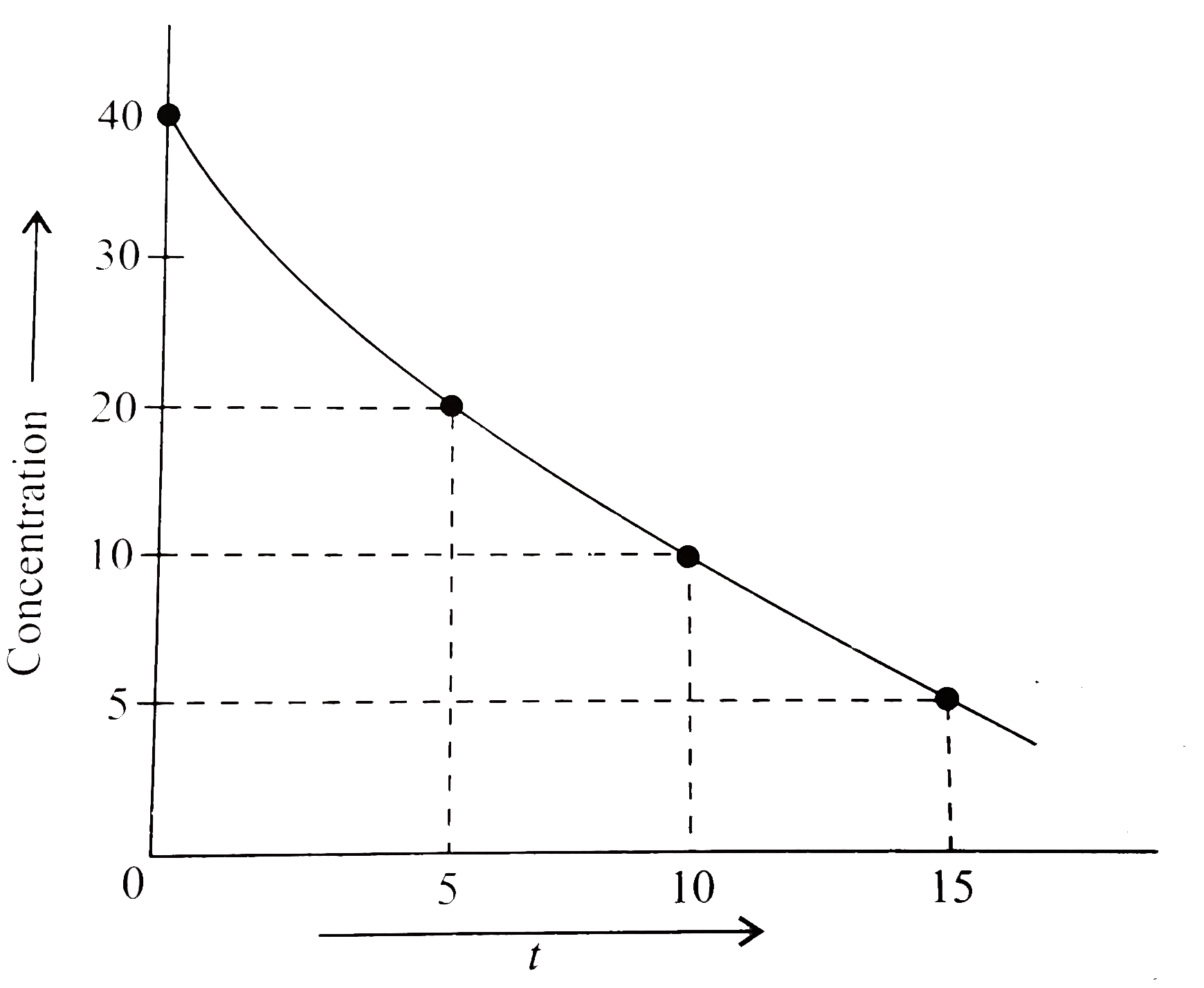
Identify the order of the reaction with respect to the reactant. Can the concentration of the reactant be theoretically zero after infinite time?03:36View Solution`2A + 3B rarr `Product
a. What is the molecularity of the reaction?
b. What is order w.r.t. `A` and `B` in the following cases:
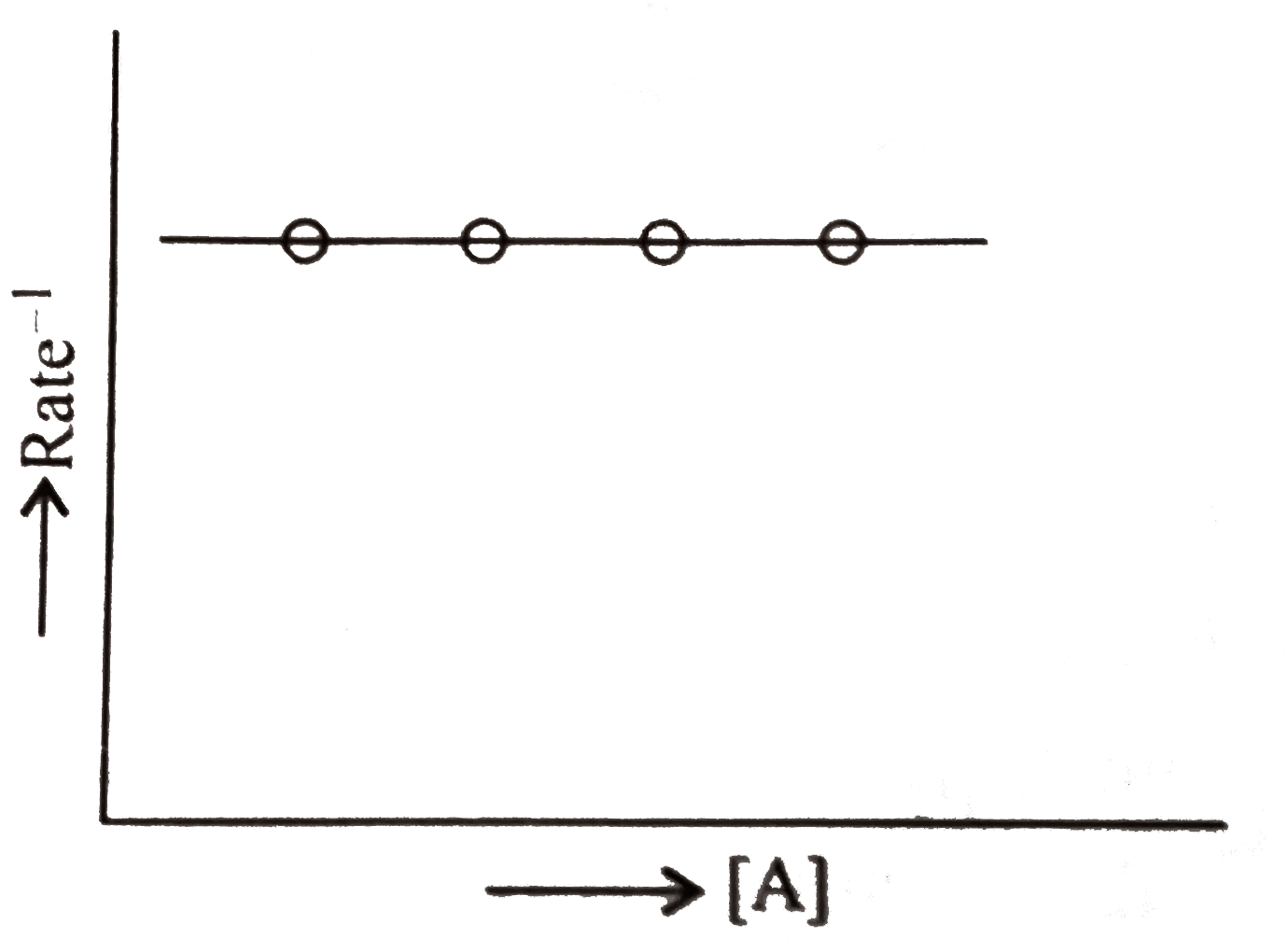
i. When `((dx)/(dt)) = k[A]` and `B` is in excess.
ii. When `((dx)/(dt)) = k[B]^(2)` and graph is true.
iii. When the rate is doubled, then the concentration of `A` is doubled, and the rate is eight when the concentration of `A` and `B` is doubled.07:37View SolutionFor the hypothetical reaction
`2A + B rarr` Products
following data obtained:
`|{:("Experiment number","Initial conc of (A)" (mol L^(-1)),"Initial conc of (B)" (mol L^(-1)),"Initial rate mol" L^(-1) s^(-1),),(1,0.10,0.20,3 xx 10^(2),),(2,0.30,0.40,3.6 xx 10^(10^(3)),),(3,0.30,0.80,1.44 xx 10^(4),),(4,0.10,0.40,...,),(5,0.20,0.60,...,),(6,0.30,1.20,...,):}|`
Find out how the rate of the reaction depends upon the concentration of `A` and `B` and fill in the blanks given in the table.08:18View SolutionThe data for the reaction: `A + B overset(k)rarr C`.
`|{:("Experiment",[A]_(0),[B]_(0),"Initial rate"),(1,0.012,0.035,0.10),(2,0.024,0.070,0.80),(3,0.024,0.035,0.10),(4,0.012,0.070,0.80):}|`
The rate law corresponding to the above data is
(a) Rate `= k[B]^(3)` , (b) Rate `= k[B]^(4)`
( c) Rate `= k[A][B]^(3)` , (d) Rate `= k[A]^(2)[B]^(2)`05:26View SolutionRate of a reaction `A + B rarr` Product, is given as a function of different initial concentration of `A` and `B`.
`|{:([A] (mol L^(-1)),(B) (mol L^(-1)),"Initial rate" (mol L^(-1) min^(-1)),),(0.01,0.01,0.005,),(0.02,0.01,0.010,),(0.01,0.02,0.005,):}|`
Determine the order of the reaction with respect to `A` and with respect to `B`. What is the half life of `A` in the reaction ?05:45View SolutionFor a reaction in which `A` and `B` form `C`, the following data were obtained form theee experiments:
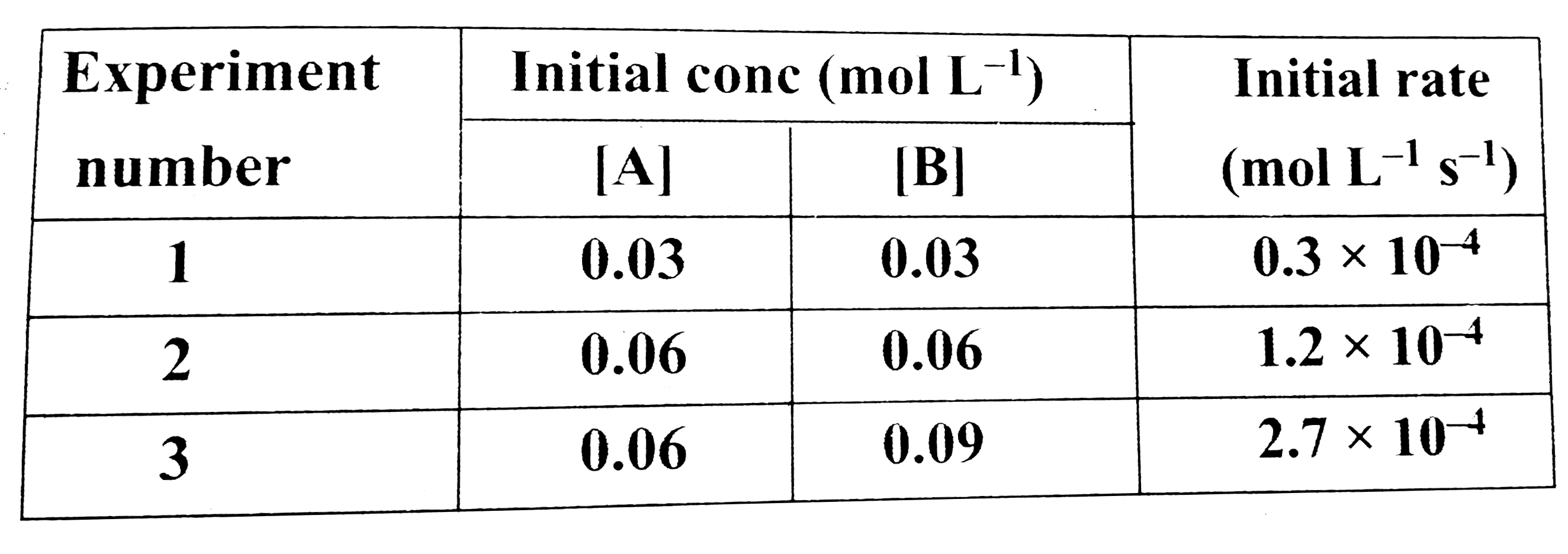
What is the rate equation of the equation and what is the value of rate constant ?06:28View SolutionThe chemical reaction between mercuric chloride and potasisum oxalate proceeds as under:
`2HgCl_(2) + K_(2)C_(2)O_(4) rarr KCl + 2CO_(2) + Hg_(2)Cl_(2)`
The mass of `Hg_(2)Cl_(2)` precipitated form different solutions in a given time at `100^(@)C` was as follows:
`|{:("Experiment number",HgCl_(2) (mol L^(-1)),K_(2)C_(2)O_(4) (mol L^(-1)),"Time (min)",Hg_(2)Cl_(2) "precipitated (mole)"),(1,0.0836,0.404,65,0.0068),(2,0.0836,0.202,120,0.0031),(3,0.0418,0.404,60,0.0032):}|`
form the data calculate order of the reaction.07:00View SolutionA certain radio isotope `._(Z)X^(A)` (half life `= 10 ` days) decays to give `._(Z-2)Y^(A-4)` . If `1.0 g` atom of `X` is kept in a sealed vessel, find the volume of helium accumulated at `STP` in `20` days ?
03:27View SolutionThe population of India in 1998 was `800` million. What will be the population in `2000` and `2100` if there is no change in the present growth rate which is `25` per `1000` per year?
06:16View SolutionThe experiment data for the reaction `2A + B_(2) rarr 2AB` is
`|{:("Experiment",[A] M,[B_(2)] M,"Initial rate" (mol L^(-1) s^(-1)),),(I,0.50,0.5,1.6 xx 10^(-4),),(II,0.50,1.0,3.2 xx 10^(-4),),(III,1.00,1.0,3.2 xx 10^(-4),):}|`
Write the most probable rate equation for the reacting giving reason for you answer.05:00View Solutionform the gaseous reaction
`2A + B_(2) rarr 2AB`, the following rate data were obtained at `300 K`.

Calculate the rate constant for the reaction and the rate of formation of `AB` when `[A]` is `0.02` and `[B_(2)]` is `0.04 mol L^(-1)` at `300K`.09:34View SolutionFor a chemical reaction `A rarr B`, it is found that the rate of reaction doubles when the concentration of `A` is increased `4` times. What is the order of reaction ? Suggest the rate law also.
02:00View SolutionFor a hypothetical reaction `A + B rarr C`, suggest the rate law and order form the following data:
`|{:("Experiment",[A] (mol L^(-1)),[B] (mol L^(-1)),"Refer of reaction" (mol L^(-1) s^(-1)),),(I,0.25,0.25,3.0 xx 10^(-3),),(II,0.50,0.25,6.0 xx 10^(-3),),(III,0.50,0.50,1.20 xx 10^(-2),):}|`04:48View SolutionFor the chemical reaction
`A + B + C rarr E`,
The rate of reaction is doubled when the concentration of `B` was doubled, and when the concentration of both `A` and `B` were doubled the rate becomes doubled and when the concentration of both `B` and `C` were doubled the rate becomes quardrupled. What is order with respect `A, B`, and `C` and total order?06:13View SolutionFor the chemical reaction `A + 2B rarr C`, the rate of reaction is increased by `2.82` times when the concentration of `A` is doubled and increased by `9` times when the concentration of `B` was tripled. What is the order with respect to `B` and `A` and total order ?
04:34View SolutionThe rate of a gaseous reaction is given by the expresison `k[A]^(2)[B]^(3)`. The volume of the reaction vessel is suddenly reduced to one-half of the initial volume. The reaction rate relative to the original rate will be
02:39View SolutionFor a chemical reaction `A rarr B`, the rate of reaction increases by a factor of `1.837` when the concentration of `A` is increased by `1.5` time. The order of reaction with respect to `A` is:
02:14View SolutionThe rate of the reaction
`3A + 2B rarr` Products
is given by the rate expresison: Rate `= k[A][B]^(2)`
If `A` is taken in excess, the order of the reaction would be01:54View SolutionFor the decompoistion of `HI` at `1000 K(2HI rarr H_(2)+I_(2))`, following data were obtained:
`|{:([HI] (M),"Rate of decomposition of HI" (mol L^(-1) s^(-1))),(0.1,2.75 xx 10^(-8)),(0.2,11 xx 10^(-8)),(0.3,24.75 xx 10^(-8)):}|`
The order of reaction is03:40View SolutionWhat will be the initial rate of a reaction if its rate constant is `10^(-3) min^(-1)` and the concentration of reactant is `0.2 mol dm^(-3)` ? How much of reactant will be converted into Products in `200 min`?
03:22View SolutionWhich of the following graphs is not for zero order reaction?
05:57View SolutionUsing the given graph showing concentration of reactants and Products as a function of times for the reaction:
`A_(3) rarr 3A`
The time `t_(1)` corresponds to
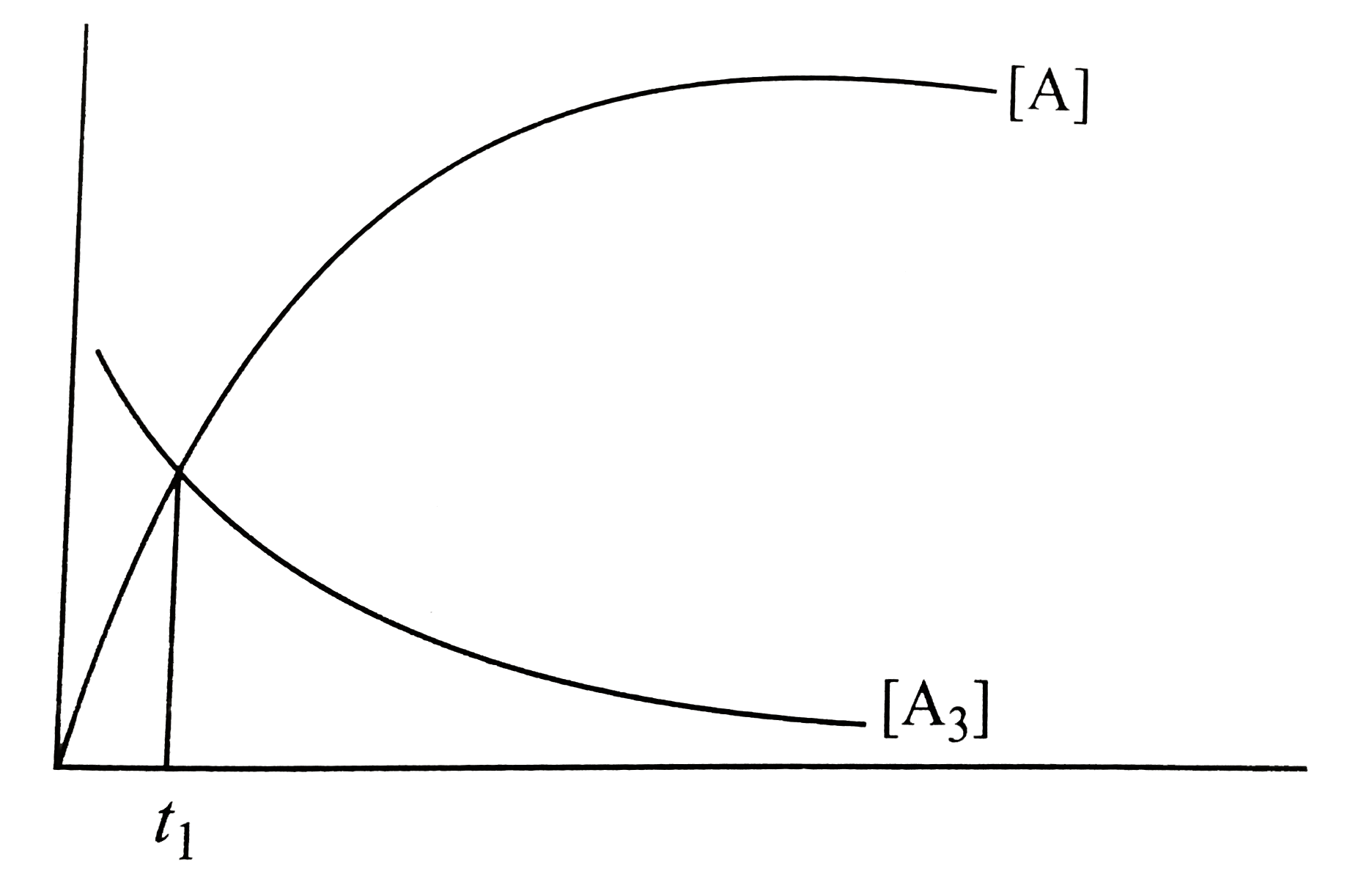 01:38View Solution
01:38View SolutionThe plot of In `(c_(0))/(c_(0)-x)` against `t` is a straight line, showing the reaction to be a
03:02View SolutionThe reaction
`CH_(3)COF + H_(2)O rarr CH_(3)COOH + HF`
has been studied under the following initial conditions
`{:(Case I,,,Case II,),([H_(2)O]_(0) = 1.00 M,,,[H_(2)O]_(0)=0.02M,),([CH_(3)COF]_(0) = 0.01 M,,,[CH_(3)COF]_(0) = 0.80 M,):}`
Concentration were monitored as a function of time and are given below:
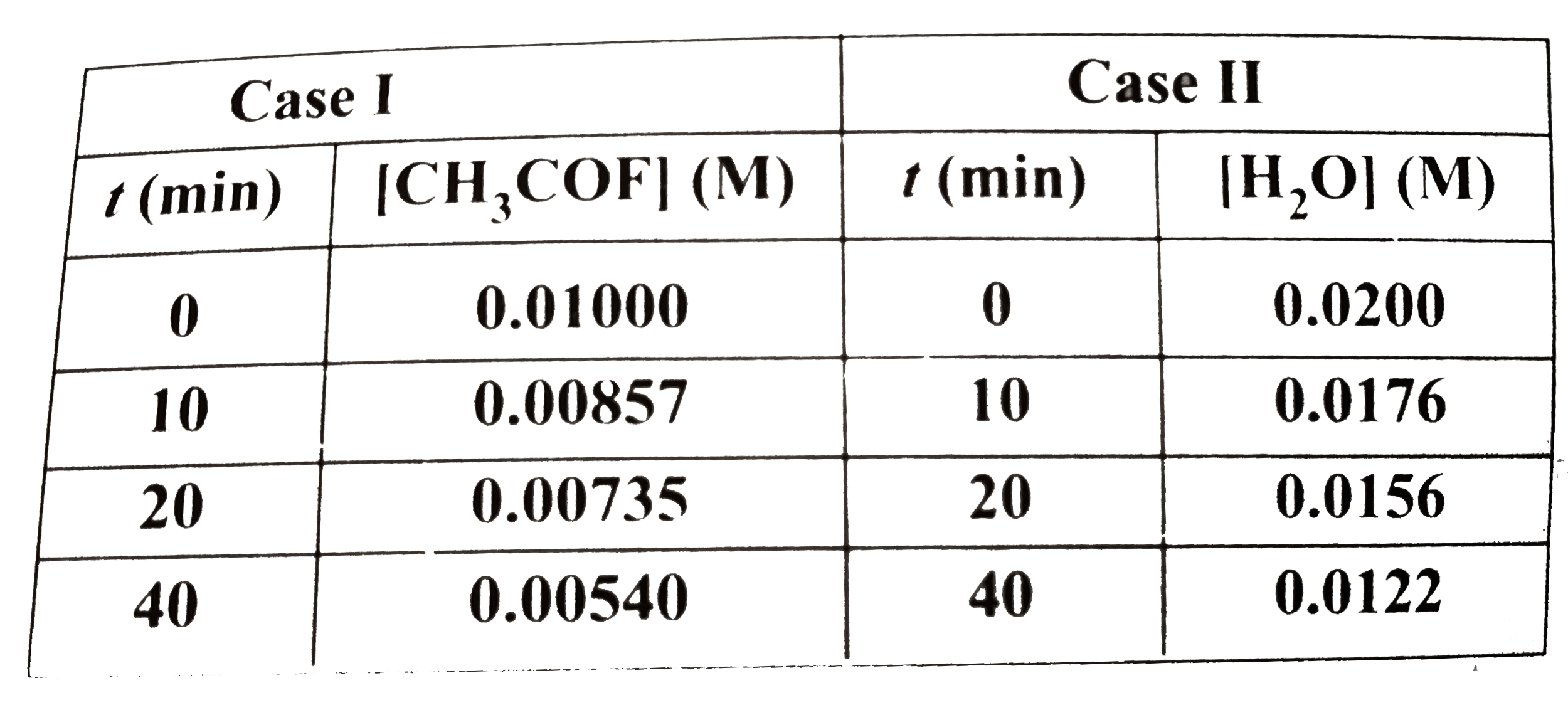
Determine the order of reaction and rate constant for the reaction.13:49View SolutionThe half-life periof and initial concentration for a reaction are as follows. What is order of reaction ?
`|{:("Initial concentration (M)",350,540,158),(t_(1//2) (hr),425,275,941):}|`03:34View Solution
Illustration questions and complete solutions for chapter CHEMICAL KINETICS of CENGAGE CHEMISTRY (HINGLISH) of Class 12
All Exercises from CENGAGE CHEMISTRY Class 12 CHEMISTRY CHEMICAL KINETICS
- Archives Fill In The Blanks
- Archives Integer
- Archives Multiple Correct
- Archives Single Correct
- Archives Subjective
- Archives True/False
- Ex 4.1 (Objective)
- Ex 4.2 (Objective)
- Ex 4.3 (Objective)
- Ex 4.3 More Than One Correct
- Ex4.4 Objective
- Exercises Assertion-Reasoning
- Exercises Fill In The Blanks
- Exercises Integer
- Exercises Linked Comprehension
- Exercises Multiple Correct
- Exercises Single Correct
- Exercises True/False
- Illustration
- Solved Example
